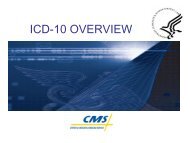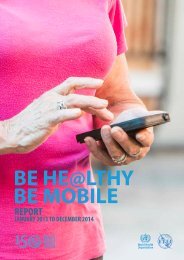mhealth_compendium_volume_3_a4_small
mhealth_compendium_volume_3_a4_small
mhealth_compendium_volume_3_a4_small
You also want an ePaper? Increase the reach of your titles
YUMPU automatically turns print PDFs into web optimized ePapers that Google loves.
DATA COLLECTIONNurses in India detected diarrhea outbreaks andidentified the source of origin, which was a religiousfestival gathering. The value of collecting data on noncommunicablediseases and non-priority communicablediseases were evident when TCWI revealed trends andpopulation segments in specific geographic locations thatwere vulnerable to life-style-associated and respiratorydiseases. Central healthcare workers were takingadvantage of the Sahana Alerting tool to shareinvestigation information with field-level healthinspectors through SMS. Previously, the inspectorswould have had to make a long journey to the centraloffice to collect this paper-based information, and then,return to their village to conduct the investigation.Lessons LearnedFrontline health workers found the standard mobilephone numeric keypad difficult to use, particularlywhen entering large numbers of recordsMany records entered into the system containederrors that could likely be eliminated throughimproved user interface design and a mobile phoneapplicationWhile desktop computers, provided by thegovernment, were harder to maintain and not oftenused, healthcare workers took it upon themselvesto maintain the mobile phones as they served a dualpurpose for both official and personal use.TCWI was able to apply statistical methods todetect data inconsistencies and entry errors; whichthe project verified as a result of occasional falsereporting to maintain statistics to implicate jobsecurityConclusionThe project demonstrated that new ICTs candramatically reduce turnaround time for outbreakdetection and alerting from weeks to a matter of daysor even hours. It also demonstrated the feasibility ofusing low-cost mobile phones and existing commercialcellular infrastructure and services to enable affordable,real-time reporting of patient records from communityhealth centers. However, further research is needed tobetter understand the challenges associated with scalingsuch a system up to a regional or national level. Furtherwork needs to be done to optimize data entry over lowcost mobile devices, to address usability and trainingrequirements for the analytics platform, and to continueto enhance and integrate health notification into nationaland regional systems and practices.--------------------------------------------------------Geographic Coverage: India, Sri LankaImplementation Partners: Carnegie Mellon University'sAuton Lab, USA; Epidemiology Unit, Ministry of Health andNutrition, Sri Lanka; Indian Institute of Technology-Madras;LIRNEasia; National Center for Biological Science,Bangalore, India; National Institute of CommunicableDiseases, Ministry of Family and Welfare, Tamil Nadu,India; Sarvodaya Shramadana Movement; University ofAlbertaFunder: Canada’s International Development ResearchCenter (IDRC)Contact Information:Partner Name: Nuwan Waidyanatha, Senior ResearchFellow (nuwan@lirneasia.net)IDRC: Laurent Elder, Program Officer (lelder@idrc.ca)References:1. Sampath, W.G.C. et al. 2010, Real-time Bio-surveillance PilotProgramme in Sri Lanka: Lessons Learned, Sri-Lanka Journal ofBio-Medical Informatics 1(3): 139-1542. Gow G.A. et al. 2010, Using Mobile Phones in a Real-TimeBiosurveillance Program: Lessons from the Frontlines in SriLanka and India, 2010 IEEE International Symposium onTechnology and Society (ISTAS ’10), Wollongong, New SouthWales, Australia3. Waidyanatha, N.2010, Evaluation of an InformationCommuniation Technology Pilot in Support of Public Health inSouth Asia, International Development Research Center4. Waidyanatha, N. 2008, Real-Time Biosurveillance Program: AResearch Proposal, LIRNEasiaPhoto credits: LIRNEasiamHEALTH COMPENDIUM | VOLUME 3 29





